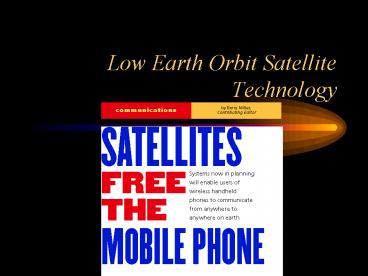Low Earth Orbit Satellite Technology - PowerPoint PPT Presentation
1 / 16
Title:
Low Earth Orbit Satellite Technology
Description:
GEO illuminate 1/3 of earths surface at 35,800km, 400ms delay ... Iridium, Thuraya and Garuda Satellites. Phone Terminals. 48 satellite Globalstar Constellation ... – PowerPoint PPT presentation
Number of Views:135
Avg rating:3.0/5.0
Title: Low Earth Orbit Satellite Technology
1
Low Earth Orbit Satellite Technology
2
Mobile Phone Technologies
- Supply Dialup Telephones and data
- Switch from terrestrial to satellite
- Satellite not able to penetrate buildings
- GEO illuminate 1/3 of earths surface at 35,800km,
400ms delay - MEO 5000-12,000km, 10 satellites, 100ms
- LEO 500-1500km, 40-70 satellites, 10ms
3
Iridium, Thuraya and Garuda Satellites
4
(No Transcript)
5
Phone Terminals
6
48 satellite Globalstar Constellation
7
MEO Antenna Array
8
SkyBridge
- An Example of an
- LEO Satelite system
- By
- Chris Crabtree
9
What is SkyBridge?
- SkyBridge is a satellite-based system
designed to provide global access to interactive,
multimedia communications. Built around a
constellation of 80 low earth orbit satellites,
SkyBridge provides the communications
infrastructure for a full range of broadband
services, including Internet access and high
speed data communications. SkyBridge can also
provide narrowband services and infrastructure
links.
10
SkyBridge Advantages
- High-reliability through simple architecture -
All traffic management and routing is handled on
the ground there is no need for direct links
between satellites. - High local content - The gateway handles
interconnections with local servers and with
terrestrial telecommunications networks. Each
gateway controls and manages all SkyBridge
traffic within its respective coverage area.
11
Advantages Continued..
- Full compatibility with existing applications
-Because it uses low earth orbit satellites,
SkyBridge propagation times are akin to those for
landline broadband transmission systems, i.e. 20
milliseconds (compared to 500 milliseconds for
geo stationary satellites). This means that
applications currently used or in development for
existing broadband networks can be seamlessly
transmitted via SkyBridge. - Huge, incremental capacity - SkyBridge will
provide worldwide coverage starting with around
40 satellites. As new satellite links are
progressively rolled out, the total system
capacity increases, attaining over 20 million
simultaneously connected end-users with 80
satellites in place. - Low cost - Capital cost per end-user is
equivalent to investment cost for terrestrial
broadband infrastructure in dense areas.
12
How it works
The system is based on a constellation of 80 LEO
satellites which link professional and
residential users equipped with low-cost
terminals to terrestrial gateways. User terminals
are not specific to the system and the
architecture of the receiving sites may be
adapted to the following configurations
individual reception, community reception (a
SkyBridge terminal is shared between several
subscribers) and professional configuration where
the SkyBridge terminal is connected to a LAN or a
PBX
For Example
13
(No Transcript)
14
About the Satellites
Each satellite is in a circular orbit at an
altitude of 1457 km above the Earth. The
constellation is divided into two symmetrical
Walker sub-constellations of 40 satellites each.
A satellite has a 3000 km radius coverage
divided into fixed spot beams of 350 km radius.
Each user is attached to one and only one
SkyBridge gateway. The traffic to and from any of
the SkyBridge users will always be concentrated
on the gateway where the user is registered.
15
(No Transcript)
16
When will SkyBridge be operational?
- The SkyBridge project is designed for rapid
implementation, with service to be rolled out by
the end of 2001. - The lifetime of the first-generation satellite
constellation is projected out to 2009.































